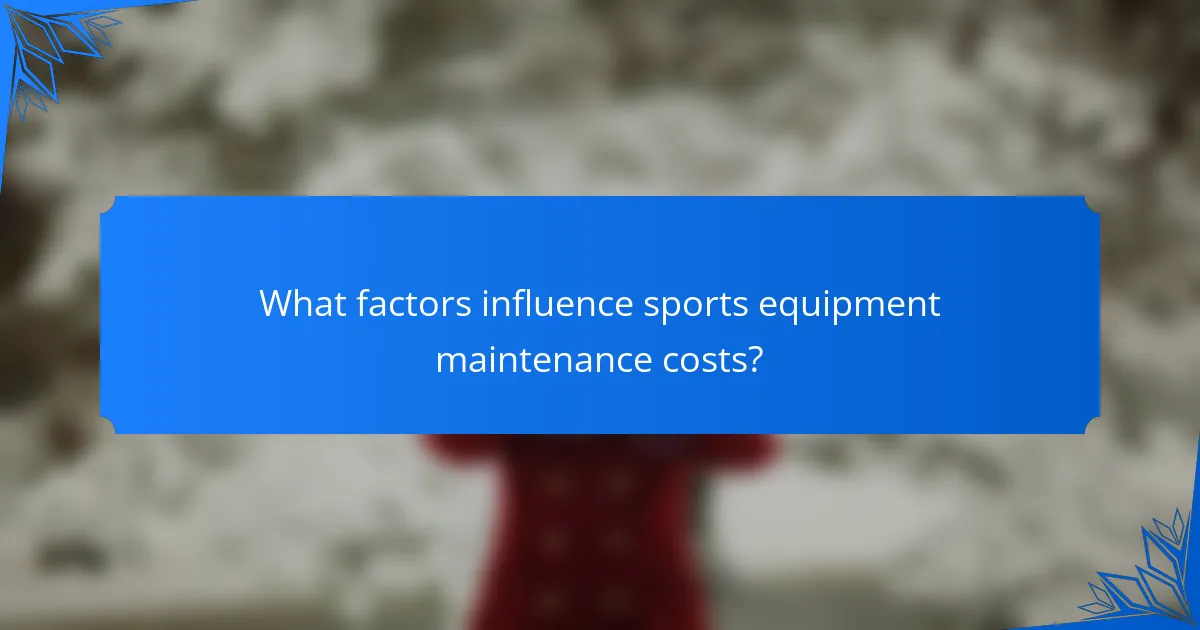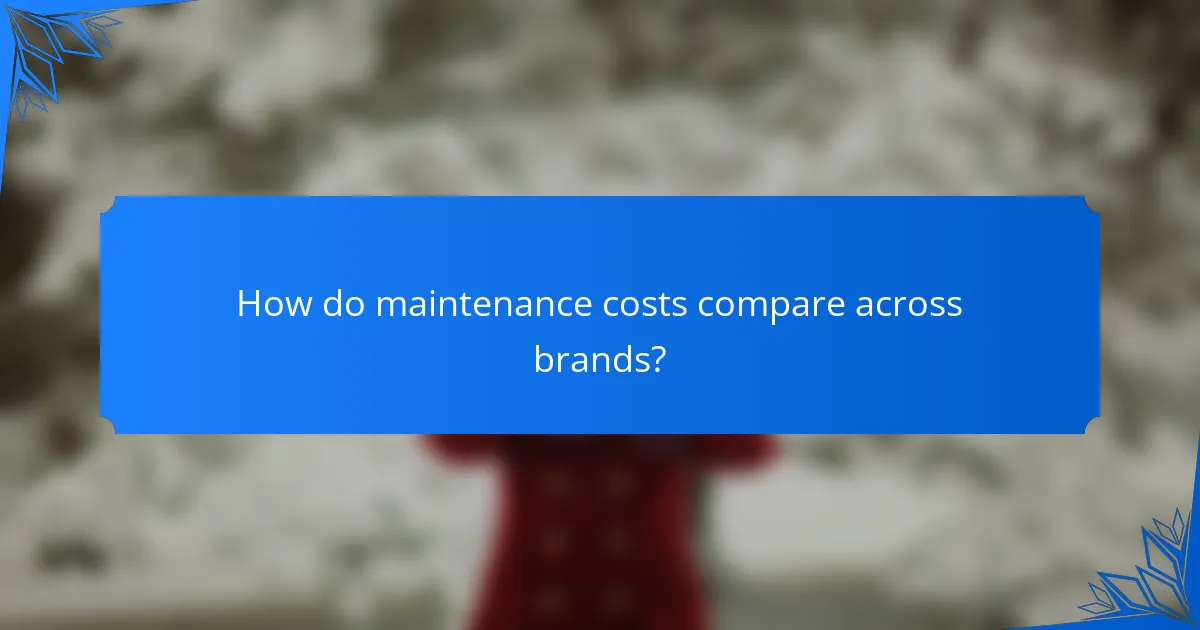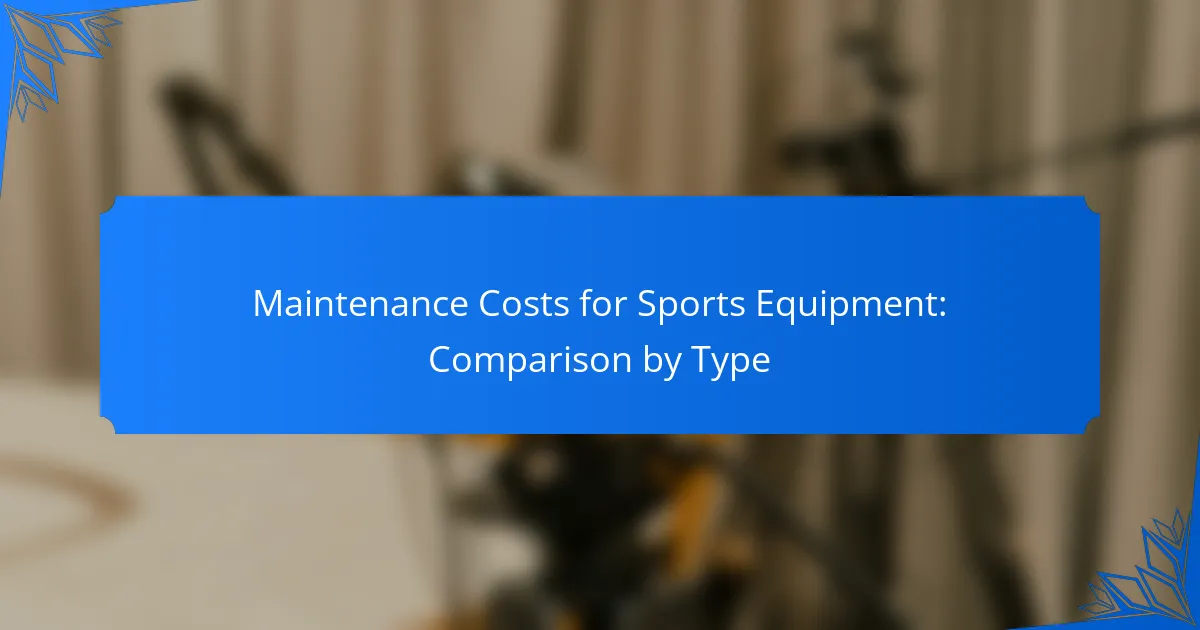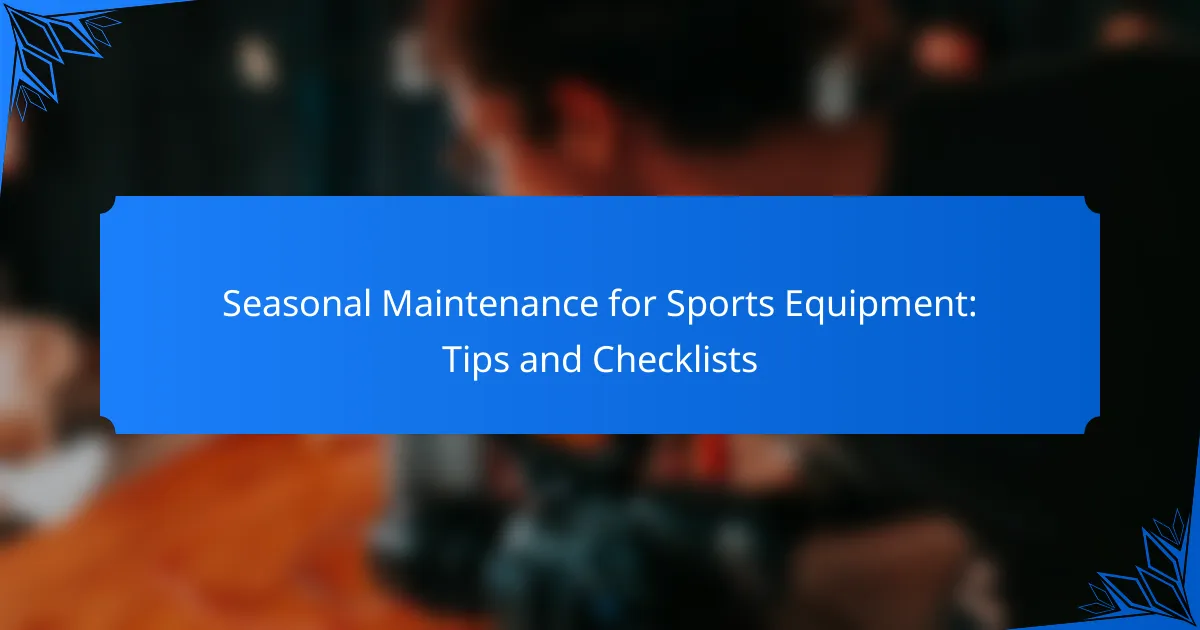Maintenance costs for sports equipment can significantly impact an athlete’s budget, varying based on the type of sport and frequency of use. Team sports often lead to higher ongoing expenses due to shared gear and facilities, while individual sports may present more variable costs influenced by personal choices. By understanding these factors, athletes can effectively manage their budgets and keep their equipment in top condition.

What are the maintenance costs for different types of sports equipment?
Maintenance costs for sports equipment vary widely depending on the type and usage. Understanding these costs can help athletes budget effectively and ensure their gear remains in optimal condition.
Costs for bicycles
Bicycle maintenance typically ranges from $50 to $200 annually, depending on usage and type. Regular services include tire replacements, brake adjustments, and chain lubrication.
For avid cyclists, investing in quality components can reduce long-term costs. Performing basic maintenance, such as cleaning and checking tire pressure, can also extend the lifespan of the bike.
Costs for tennis rackets
The maintenance costs for tennis rackets are generally low, averaging around $20 to $50 per year. String replacement is the primary expense, which may be needed every few months for frequent players.
Choosing the right string type and tension can impact performance and durability. Regularly inspecting the frame for cracks or damage is also essential to avoid costly replacements.
Costs for football gear
Football gear maintenance costs can range from $30 to $100 annually. This includes cleaning uniforms, replacing worn-out cleats, and ensuring helmets meet safety standards.
Players should regularly check their equipment for wear and tear, especially helmets and pads, to maintain safety and performance. Proper storage can also prolong the life of the gear.
Costs for golf clubs
Maintaining golf clubs usually costs between $50 and $150 per year. This includes re-gripping, cleaning, and occasional shaft repairs or replacements.
Investing in quality grips and regularly cleaning clubs can enhance performance and longevity. Players should also consider having their clubs fitted for optimal performance.
Costs for running shoes
Running shoe maintenance costs are relatively low, typically around $20 to $50 annually, primarily for cleaning and occasional replacement of insoles. However, replacing shoes every 300 to 500 miles is crucial for injury prevention.
Proper care, such as air drying and avoiding harsh conditions, can extend the life of running shoes. Keeping track of mileage can help runners know when to replace their footwear.

How do maintenance costs vary by sport in the UK?
Maintenance costs for sports equipment in the UK can differ significantly based on the type of sport. Team sports generally incur higher ongoing costs due to shared equipment and facilities, while individual sports may have more variable costs depending on personal equipment choices.
Maintenance for team sports
Team sports, such as football and rugby, often require regular maintenance of shared equipment like balls, nets, and protective gear. Costs can range from low tens of pounds for basic upkeep to several hundred pounds for more extensive repairs or replacements.
Additionally, facilities used for team sports may require maintenance fees, which can include pitch upkeep and facility rentals. Clubs should budget for these costs annually to ensure they can cover necessary repairs and replacements.
Maintenance for individual sports
Individual sports, such as tennis or cycling, typically involve personal equipment that requires maintenance based on usage. For instance, a tennis racket may need string replacements every few months, costing around £20-£30, while a bicycle may require tune-ups and part replacements that can add up to £50-£100 annually.
Athletes should consider the frequency of use and the type of equipment when estimating maintenance costs. Regular checks and timely repairs can prevent more expensive issues later, making it crucial to stay proactive about equipment care.

What factors influence sports equipment maintenance costs?
Sports equipment maintenance costs are influenced by several key factors, including how often the equipment is used, the materials it is made from, and the reputation of the brand. Understanding these elements can help you budget effectively and ensure your gear remains in optimal condition.
Frequency of use
The frequency of use directly impacts maintenance costs. Equipment that is used regularly, such as running shoes or bicycles, may require more frequent repairs and replacements compared to items that are used occasionally, like golf clubs or tennis rackets.
A general rule of thumb is that the more often you use the equipment, the higher the maintenance costs. For example, a pair of running shoes may need replacement every 300 to 500 miles, while a rarely used kayak might last for years with minimal upkeep.
Type of material
The materials used in sports equipment significantly affect maintenance costs. High-quality materials, such as carbon fiber or specialized alloys, may have higher upfront costs but can lead to lower maintenance expenses over time due to their durability.
Conversely, equipment made from lower-quality materials may be cheaper initially but could require more frequent repairs or replacements. For instance, a synthetic tennis racket may need to be replaced every season, while a wooden one, if cared for properly, can last for several years.
Brand reputation
Brand reputation plays a crucial role in determining maintenance costs. Well-established brands often provide better warranties and customer service, which can reduce long-term costs associated with repairs and replacements.
Choosing a reputable brand may mean higher initial costs, but it can save money in the long run. For example, premium brands in cycling gear may offer products that last longer and require less maintenance compared to lesser-known brands, which might have lower quality and higher upkeep needs.

How can I reduce maintenance costs for sports equipment?
To reduce maintenance costs for sports equipment, focus on regular upkeep, proper storage, and exploring DIY repair options. Implementing these strategies can extend the lifespan of your gear and minimize unexpected expenses.
Regular cleaning tips
Regular cleaning is essential for maintaining sports equipment and preventing wear and tear. For most gear, a simple rinse with water and mild soap can remove dirt and grime. Make sure to dry items thoroughly to avoid mold and rust.
Specific cleaning techniques vary by equipment type. For example, wipe down tennis rackets with a damp cloth, while football helmets may require a gentle scrub with a soft brush. Always refer to manufacturer guidelines for best practices.
Proper storage techniques
Proper storage can significantly reduce maintenance costs by protecting equipment from damage. Store items in a cool, dry place away from direct sunlight to prevent deterioration. Use padded bags or cases for delicate gear like bicycles or skis.
Organizing equipment neatly can also help. Consider using shelves or hooks to keep items off the ground and prevent accidental damage. For seasonal sports gear, ensure everything is clean and dry before storing it away for long periods.
DIY repair options
Many minor repairs can be handled at home, saving you money on professional services. For instance, replacing worn grips on tennis rackets or fixing small tears in sports apparel can be done with basic tools and materials.
Online tutorials and videos are valuable resources for learning DIY repair techniques. However, assess your skill level and the complexity of the repair; some tasks may require professional assistance to avoid further damage.

What are the long-term maintenance costs of sports equipment?
The long-term maintenance costs of sports equipment can vary significantly based on the type of equipment, usage frequency, and care practices. Generally, these costs include repairs, replacements, and routine upkeep, which can accumulate over time, impacting overall ownership expenses.
Projected costs over five years
Over a five-year period, maintenance costs for sports equipment can range from a few hundred to several thousand dollars, depending on the category. For instance, team sports gear like soccer or basketball equipment may require less upkeep compared to individual sports gear such as bicycles or golf clubs, which often need more frequent servicing.
Regular maintenance tasks, such as cleaning, lubricating, and inspecting equipment, can help mitigate larger repair costs. Budgeting around 10-20% of the initial purchase price annually for maintenance can provide a reasonable estimate for long-term expenses.
Comparison of new vs. used equipment
New sports equipment typically comes with warranties and lower initial maintenance costs, but it may depreciate quickly. In contrast, used equipment can be more affordable upfront but may require more frequent repairs and maintenance, leading to higher long-term costs.
When considering used equipment, it’s essential to assess its condition and potential repair needs. A thorough inspection can help identify any immediate maintenance requirements, allowing for a more accurate comparison of total costs over time.

How do maintenance costs compare across brands?
Maintenance costs for sports equipment vary significantly across brands, influenced by factors such as materials, design, and the availability of parts. Understanding these differences can help consumers make informed decisions about their purchases and long-term upkeep.
Comparison of leading bicycle brands
When comparing leading bicycle brands, maintenance costs can range from moderate to high depending on the brand’s reputation and the complexity of their designs. For instance, brands like Trek and Specialized often have higher maintenance costs due to their advanced technology and premium components, which may require specialized tools or services.
On the other hand, brands such as Giant and Cannondale may offer more affordable maintenance options, as they tend to use more standardized parts that are widely available. Regular upkeep, including tire changes and brake adjustments, typically costs between $50 to $150 annually, depending on usage and brand-specific requirements.
Comparison of tennis racket brands
In the realm of tennis rackets, maintenance costs are generally lower than those for bicycles, primarily involving string replacements and grip adjustments. Leading brands like Wilson and Babolat offer a variety of strings that can range from $15 to $30 per restringing, depending on the type and quality chosen.
Additionally, brands such as Head and Prince may have slightly lower costs due to their more affordable string options. Players should consider restringing their rackets every few months, especially if they play frequently, to ensure optimal performance and longevity of the equipment.


